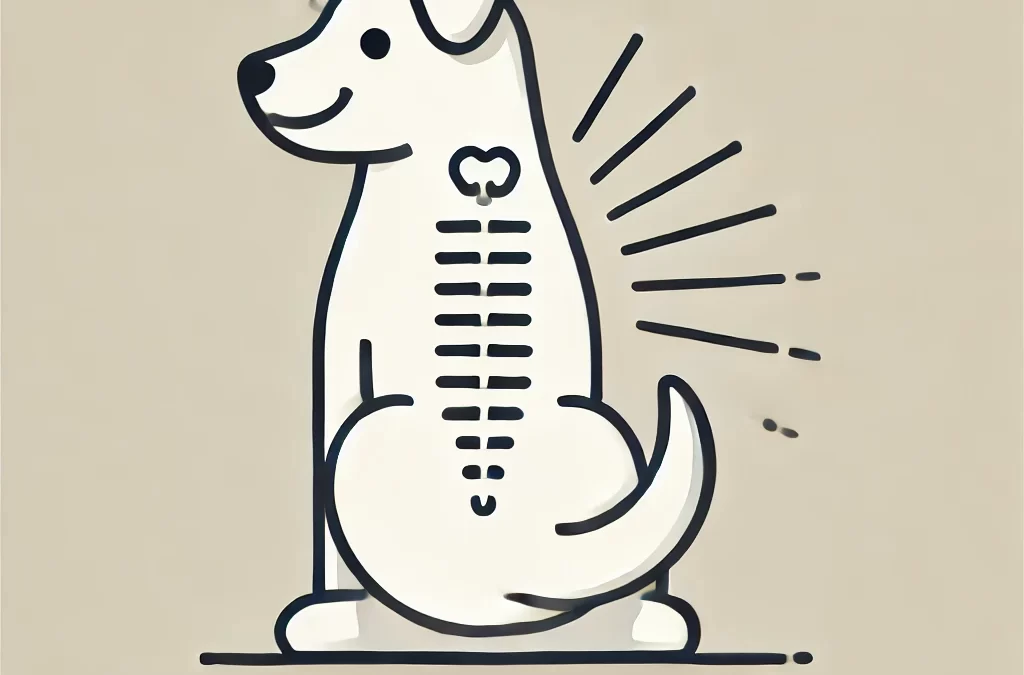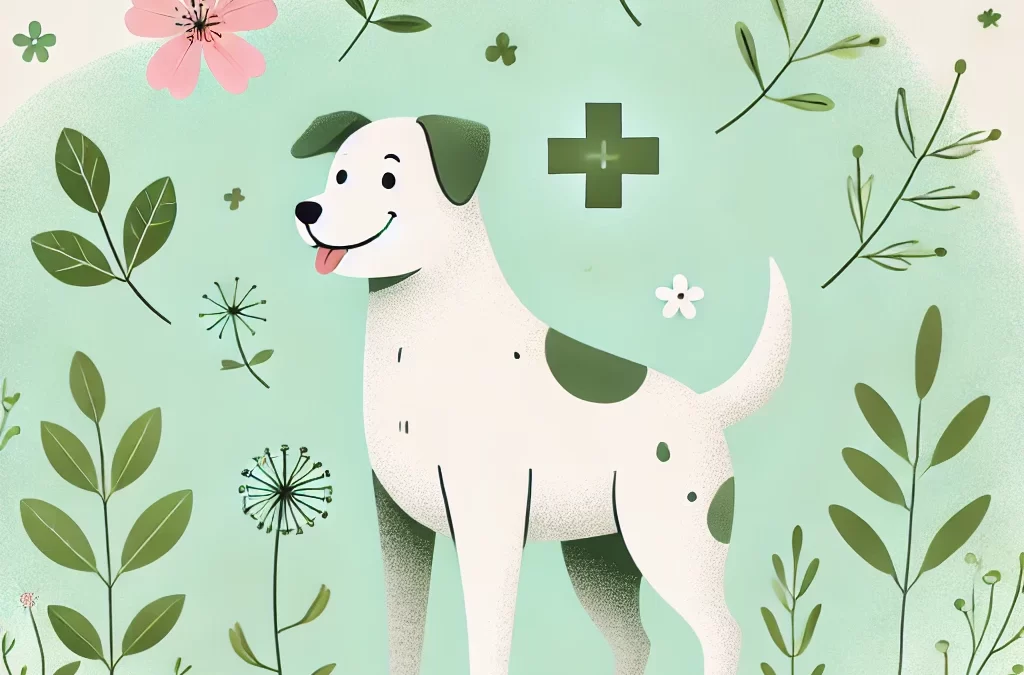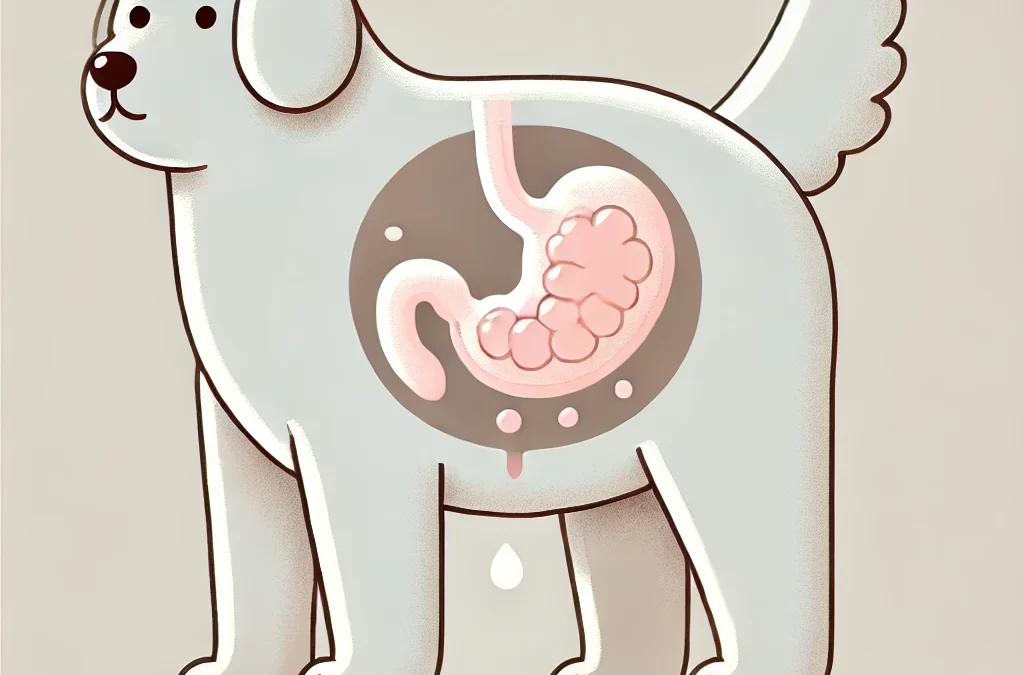
par TCMVET | 9 décembre 2024 | Cancer et tumeurs du chien
Les tumeurs de la colonne vertébrale chez les chiens, bien que rares, peuvent avoir de graves répercussions sur leur mobilité et leur qualité de vie. Ces tumeurs peuvent se développer à l'intérieur ou autour de la colonne vertébrale, affectant le fonctionnement du système nerveux. Une détection précoce et une gestion appropriée sont essentielles pour fournir les meilleurs soins à votre ami à quatre pattes. Voici un guide complet sur les types de tumeurs de la colonne vertébrale chez les chiens et leurs symptômes, causes et options de traitement.
Types courants de tumeurs de la colonne vertébrale chez le chien
- Tumeurs intramédullaires
- Description: Ces tumeurs se développent dans la moelle épinière elle-même. Elles proviennent souvent des cellules gliales, qui soutiennent le système nerveux.
- Exemples : Astrocytomes, épendymomes et oligodendrogliomes
- Symptômes: Faiblesse progressive, incoordination et possible paralysie dans les cas graves
- Traitement : Chirurgie (si possible), radiothérapie et soins de soutien
- Tumeurs extradurales
- Description: Ces tumeurs se produisent à l’extérieur de la moelle épinière mais à l’intérieur du canal rachidien, comprimant souvent la moelle et provoquant des problèmes neurologiques.
- Exemples : Ostéosarcomes, fibrosarcomes et lymphomes
- Symptômes: Maux de dos, difficulté à marcher et faiblesse musculaire
- Traitement : Ablation chirurgicale, chimiothérapie ou radiothérapie, selon le type de tumeur
- Tumeurs intradurales-extramédullaires
- Description: Situées dans le canal rachidien mais à l’extérieur de la moelle épinière, ces tumeurs se développent dans les méninges ou les racines nerveuses environnantes.
- Exemples : Méningiomes, tumeurs des gaines nerveuses (schwannomes)
- Symptômes: Douleur, incoordination et possible incontinence urinaire ou intestinale
- Traitement : Chirurgie et radiothérapie
- Tumeurs vertébrales
- Description: Ces tumeurs proviennent des os de la colonne vertébrale, provoquant une instabilité structurelle et une compression potentielle de la moelle épinière.
- Exemples : Ostéosarcome, chondrosarcome
- Symptômes: Douleur intense, gonflement et difficulté à se tenir debout ou à marcher
- Traitement : Chirurgie, chimiothérapie et gestion de la douleur
Symptoms of Spinal Tumors in Dogs
Les symptômes des tumeurs de la colonne vertébrale peuvent varier en fonction de l’emplacement et de la taille de la tumeur, mais les signes courants incluent :
- Réticence à bouger ou à jouer
- Difficulté à marcher ou à traîner les membres
- Douleur ou sensibilité dans le dos ou le cou
- Perte de contrôle de la vessie ou des intestins
- Changements soudains de comportement ou de posture
Causes et facteurs de risque
Les tumeurs de la colonne vertébrale chez les chiens peuvent être causées par :
- Prédisposition génétique: Certaines races comme les bergers allemands et les golden retrievers peuvent être plus à risque.
- Age: Les chiens plus âgés sont plus susceptibles de développer des tumeurs de la colonne vertébrale.
- Métastase cancéreuse : Des tumeurs provenant d’autres parties du corps peuvent se propager à la colonne vertébrale.
Diagnostic et traitement
Les vétérinaires utilisent plusieurs méthodes pour diagnostiquer les tumeurs de la colonne vertébrale :
- Examen neurologique : Évalue les réflexes, la coordination et la réponse à la douleur.
- Imagerie : Radiographies, IRM ou tomodensitométrie pour localiser et évaluer la tumeur.
- Biopsie: Confirme le type de tumeur pour un traitement ciblé.
Les options de traitement comprennent :
- Chirurgie : La méthode privilégiée pour les tumeurs accessibles et opérables.
- Radiothérapie : Utilisé pour les tumeurs inopérables ou résiduelles après une intervention chirurgicale.
- Chimiothérapie : Efficace pour certaines tumeurs métastatiques ou primaires de la colonne vertébrale.
- Prise en charge de la douleur : Indispensable pour améliorer la qualité de vie du chien.
Accompagner votre chien pendant sa convalescence
Les soins pour les chiens atteints de tumeurs de la colonne vertébrale doivent inclure :
- Fournir un lit moelleux et de soutien pour éviter les escarres
- Aide à la mobilité grâce à des harnais ou des chariots
- Maintenir une alimentation nutritive pour soutenir la santé globale
- Des suivis réguliers avec le vétérinaire pour surveiller les progrès
Conclusion
Les tumeurs de la colonne vertébrale chez les chiens nécessitent une attention immédiate et des soins spécialisés. Bien que le pronostic dépende du type de tumeur et de sa progression, les progrès de la médecine vétérinaire ont rendu les traitements plus efficaces. En comprenant les symptômes et les options disponibles, vous pouvez vous assurer que votre chien reçoit les meilleurs soins et le meilleur soutien.

par TCMVET | 9 décembre 2024 | Cancer et tumeurs du chien
La santé de la peau des chiens est souvent le reflet de leur bien-être général, mais certaines affections peuvent être déroutantes, même pour les propriétaires d'animaux les plus attentifs. L'une de ces affections rares est épithéliomes cornifiés, un type de tumeur cutanée bénigne qui peut susciter des inquiétudes en raison de son apparence et de ses effets. Examinons de plus près cette affection dermatologique inhabituelle, ses causes, ses traitements et ce qui en fait un défi unique dans les soins de santé canins.
Que sont les épithéliomes cornifiants ?
Les épithéliomes cornéens sont des tumeurs bénignes qui proviennent des glandes sébacées, plus précisément de l'épithélium (cellules cutanées) responsable de la production de kératine. Ces tumeurs se présentent souvent sous forme de nodules ressemblant à des verrues sur la peau d'un chien. Bien qu'elles ne mettent pas la vie en danger, leur potentiel de gêne ou d'infection signifie qu'elles ne doivent pas être ignorées.
Quelles sont les causes des épithéliomes cornifiés ?
La cause exacte des épithéliomes kératinisés n’est pas entièrement comprise, mais les facteurs contributifs peuvent inclure :
- Prédisposition génétique: Les races telles que les cockers, les beagles et les huskies de Sibérie sont plus susceptibles de développer ces excroissances.
- Déséquilibres hormonaux : L’activité des glandes sébacées peut être influencée par les changements hormonaux, en particulier chez les chiens âgés.
- Carences alimentaires : Une mauvaise nutrition peut entraîner des déséquilibres dans la santé de la peau, aggravant potentiellement des affections comme les épithéliomes.
Reconnaître les symptômes
Les épithéliomes kératinisés apparaissent généralement comme :
- Nodules petits et fermes avec une texture semblable à celle d'une verrue
- Couleur jaunâtre ou cireuse en raison de l'accumulation de kératine
- Localisée autour de la tête, du cou ou du dos, mais peut survenir n'importe où
- Parfois accompagnée de rougeur ou d'inflammation en cas d'infection secondaire
Bien que ces excroissances soient bénignes, des changements rapides de taille, de couleur ou de texture doivent être évalués par un vétérinaire pour exclure des tumeurs malignes.
Diagnostic des épithéliomes cornifiés
Le diagnostic implique généralement :
- Examen physique : Un vétérinaire évaluera la taille, l’emplacement et l’apparence des excroissances.
- Aspiration à l'aiguille fine (AAF) : Un échantillon de cellules est extrait et analysé pour confirmer la nature de la tumeur.
- Biopsie: Dans certains cas, une biopsie peut être nécessaire pour différencier les épithéliomes bénins d’autres affections cutanées ou cancers.
Options de traitement
Le traitement dépend de la gravité et de l’impact des épithéliomes sur la qualité de vie de votre chien.
- Contrôle
Pour les petites excroissances non problématiques, une surveillance régulière est souvent suffisante.
- Assurez-vous que la zone reste propre et exempte d’infection.
- Utilisez des traitements topiques apaisants si recommandés par votre vétérinaire.
- Retrait chirurgical
Si les excroissances provoquent une gêne, des infections récurrentes ou des problèmes esthétiques, l’ablation chirurgicale est une solution courante.
- Les techniques mini-invasives comme la chirurgie au laser peuvent réduire le temps de récupération.
- Thérapies topiques ou systémiques
- Les rétinoïdes ou suppléments de vitamine A peuvent réguler la production de kératine.
- Des antibiotiques peuvent être prescrits en cas d’infections bactériennes secondaires.
Des approches innovantes et naturelles
Pour les propriétaires souhaitant compléter les traitements conventionnels par des soins holistiques :
- Les acides gras omega-3: Ils peuvent réduire l’inflammation et favoriser la santé globale de la peau.
- Remèdes à base de plantes: Le calendula et l’aloe vera peuvent apaiser les zones irritées.
- Ajustements alimentaires : Une alimentation riche en antioxydants et en protéines de haute qualité favorise la régénération de la peau.
Mesures préventives
Bien que tous les cas d’épithéliomes cornifiés ne puissent pas être évités, les étapes suivantes peuvent aider à maintenir une santé cutanée optimale :
- Toilettage régulier : Maintient la peau propre et favorise la détection précoce des anomalies.
- Régime équilibré: Soutient le système immunitaire et réduit le risque de problèmes de peau.
- Visites vétérinaires de routine : Une intervention précoce est essentielle pour gérer toute affection cutanée.
Un défi unique en dermatologie canine
Les épithéliomes cornifiés soulignent l'importance de comprendre et de traiter même les maladies rares chez les chiens. Bien que bénignes, ces excroissances peuvent avoir un impact sur le confort et l'apparence de votre animal, ce qui rend essentielle une gestion rapide et efficace. En restant informé et en travaillant en étroite collaboration avec votre vétérinaire, vous pouvez vous assurer que votre chien reste en bonne santé, heureux et prospère.

par TCMVET | 8 décembre 2024 | Cancer et tumeurs du chien
Options de montage
Les chiens se lèchent souvent le corps par instinct, que ce soit pour se toiletter ou pour apaiser leur inconfort. Cependant, lorsque votre chien lèche constamment une zone spécifique, comme une tumeur, cela peut indiquer un problème sous-jacent qui nécessite une attention particulière. Cet article explore les raisons pour lesquelles les chiens lèchent les tumeurs, les risques potentiels et les moyens efficaces pour résoudre le problème.
Pourquoi les chiens lèchent-ils les tumeurs ?
Le léchage est un comportement naturel chez les chiens, mais un léchage persistant sur une tumeur peut indiquer plusieurs raisons sous-jacentes :
- Inconfort ou douleur
Les tumeurs, en particulier celles qui sont enflammées ou ulcérées, peuvent provoquer une irritation. Les chiens se lèchent souvent pour tenter de soulager cet inconfort.
- Infection ou écoulement
Certaines tumeurs peuvent produire du sang, du pus ou d’autres liquides, que les chiens tentent instinctivement de nettoyer en se léchant.
- Curiosité
Les chiens sont des créatures tactiles et sensorielles. Une excroissance ou une grosseur peut leur sembler inhabituelle, ce qui les incite à enquêter en les léchant.
- Anxiété ou stress
La détresse émotionnelle peut se manifester par un comportement de léchage. Les chiens peuvent se concentrer sur les zones d'inconfort pour s'apaiser.
Risques liés au léchage de tumeurs
Bien que le léchage puisse sembler inoffensif, il peut entraîner des complications :
- Infection:Les bactéries introduites par le léchage peuvent provoquer des infections secondaires.
- Ulcération:Un léchage persistant peut endommager la peau recouvrant la tumeur, provoquant une irritation et des saignements supplémentaires.
- Guérison retardée:Si la tumeur a été traitée ou retirée, le léchage peut perturber le processus de guérison.
- Propagation de cellules malignes:Dans de rares cas, l’irritation due au léchage peut exacerber la propagation des cellules cancéreuses.
Comment éviter le léchage
Il est essentiel de prendre des mesures immédiates pour empêcher votre chien de lécher une tumeur afin d’éviter d’autres complications.
- Consulter un vétérinaire
Un vétérinaire doit examiner la tumeur pour déterminer si elle est bénigne ou maligne et recommander un plan d’action approprié.
- Utiliser un équipement de protection
Envisagez un collier élisabéthain, un collier gonflable ou une combinaison pour empêcher votre chien d’accéder à la tumeur.
- S'attaquer à la cause profonde
Selon le diagnostic, le traitement peut impliquer une intervention chirurgicale, des médicaments ou une combinaison des deux pour soulager l’inconfort et traiter la tumeur.
- Maintenir l'hygiène
Garder la zone touchée propre et suivre les instructions de votre vétérinaire peut prévenir les infections et réduire l’irritation.
Soutenir la récupération de votre chien de manière naturelle
En plus des traitements conventionnels, les thérapies naturelles peuvent apporter un soutien supplémentaire à la santé de votre chien. Des produits comme TCMVET Baituxiao, basés sur la médecine traditionnelle chinoise, sont spécifiquement formulés pour aider à gérer la croissance tumorale et à soutenir la fonction immunitaire.
Les propriétaires d'animaux ont partagé des expériences positives avec TCMVET Baituxiao, notant des améliorations dans les niveaux d'énergie et de confort de leurs animaux. Il peut s'agir d'un excellent complément à un plan de soins complet, bien qu'il soit essentiel de consulter votre vétérinaire avant d'introduire tout nouveau supplément.
Prendre soin du bien-être de votre chien
Si votre chien lèche une tumeur, c'est un signe évident que quelque chose ne va pas. Prendre des mesures pour remédier à ce comportement et demander l'avis d'un professionnel peut faire toute la différence pour la santé de votre animal. Combiner les soins vétérinaires avec des suppléments naturels comme TCMVET Baituxiao peut améliorer la qualité de vie de votre chien et lui apporter le meilleur soutien possible pendant sa convalescence.
En restant attentif et proactif, vous pouvez vous assurer que votre chien reste à l’aise et soigné, quels que soient les défis auxquels il est confronté.

par TCMVET | 8 décembre 2024 | Cancer et tumeurs du chien
Le cancer est l'un des problèmes de santé les plus difficiles auxquels sont confrontés les propriétaires de chiens. Souvent confondus avec des signes de vieillissement ou des affections mineures, les symptômes du cancer chez les chiens peuvent facilement passer inaperçus jusqu'à ce que la maladie ait progressé. Cet article adopte une nouvelle approche pour comprendre les symptômes du cancer chez le chien et explore comment les thérapies naturelles peuvent jouer un rôle dans le soutien de la santé de votre animal.
Symptômes courants du cancer chez le chien
La détection précoce du cancer peut avoir une incidence considérable sur les résultats du traitement. Voici quelques signes courants à surveiller :
- Bosses ou gonflements:Des bosses persistantes ou un gonflement inhabituel dans des zones comme le cou, les jambes ou l’abdomen ne doivent jamais être ignorés.
- Changes in Appetite:Une perte soudaine d’intérêt pour la nourriture ou des difficultés à manger peuvent indiquer des problèmes de santé sous-jacents.
- Unexplained Weight Loss:Des changements de poids importants sans ajustements du régime alimentaire ou de l’activité physique peuvent signaler un cancer.
- Changements de comportement:Une léthargie accrue, une réticence à faire de l’exercice ou des signes d’inconfort peuvent indiquer des problèmes de santé internes.
- Décharges anormales:Un écoulement nasal persistant, du sang dans les selles ou des odeurs inhabituelles peuvent être des signes avant-coureurs.
- Plaies non cicatrisantes:Si une blessure ou une plaie ne guérit pas dans un délai raisonnable, cela pourrait indiquer un problème plus profond.
Le rôle des thérapies naturelles dans le traitement du cancer
Bien que les traitements conventionnels comme la chirurgie, la chimiothérapie et la radiothérapie soient souvent nécessaires, ils peuvent être coûteux et entraîner des effets secondaires. C'est là que les thérapies naturelles entrent en jeu comme approche complémentaire. Les herbes et les suppléments, lorsqu'ils sont soigneusement sélectionnés, peuvent aider à améliorer la qualité de vie de votre animal et à favoriser son rétablissement.
Un tel supplément naturel est TCMVET Baituxiao, une formule inspirée de la médecine traditionnelle chinoise. Elle est conçue pour aider les chiens en réduisant la croissance tumorale et en favorisant l'équilibre général du corps. Les propriétaires d'animaux ont signalé des améliorations des niveaux d'énergie et du bien-être de leur chien lorsqu'ils utilisent ce produit en complément des soins vétérinaires.
Accompagner le voyage de votre chien
Si votre chien présente l'un des symptômes mentionnés ci-dessus, consultez immédiatement votre vétérinaire pour un diagnostic approfondi. Une détection précoce, associée à une approche holistique du traitement, peut faire toute la différence dans le parcours de votre animal.
L'intégration de thérapies naturelles comme TCMVET Baituxiao dans la routine de soins de votre chien complète non seulement les traitements traditionnels, mais apporte également un soutien supplémentaire à sa santé globale. En restant informé et proactif, vous pouvez vous assurer que votre compagnon à quatre pattes reçoit les meilleurs soins possibles.

par TCMVET | 7 décembre 2024 | Cancer et tumeurs du chien
Le carcinome à cellules transitionnelles (TCC) est le type de cancer de la vessie le plus courant chez les chiens, et représente souvent des défis importants pour les animaux et leurs propriétaires. Malgré sa nature agressive, une détection précoce et une approche proactive du traitement peuvent aider à améliorer la qualité de vie d'un chien.
Qu’est-ce que le carcinome à cellules transitionnelles ?
Le carcinome épidermoïde œsophagien (TCC) est un cancer malin qui prend généralement naissance dans la paroi épithéliale de la vessie, en particulier dans la région du trigone, où l'urètre et les uretères se rencontrent. Bien qu'il affecte principalement la vessie, il peut se propager à l'urètre, à la prostate, aux ganglions lymphatiques et à d'autres organes s'il n'est pas traité.
Quels chiens sont à risque ?
Bien que le TCC puisse affecter n’importe quel chien, certaines races sont prédisposées, notamment :
- Terriers écossais (risque le plus élevé)
- Chiens de berger des Shetland
- Terriers blancs des West Highlands
- beagles
Les chiennes et les chiens plus âgés sont plus susceptibles de développer un TCC, bien que la maladie ne soit pas exclusive à ces groupes.
Symptômes à surveiller
Les premiers signes du TCC peuvent ressembler à des infections urinaires courantes, ce qui rend le diagnostic difficile. Les principaux symptômes sont les suivants :
- Effort pour uriner (dysurie)
- Augmentation de la fréquence des mictions (pollakiurie)
- Sang dans les urines (hématurie)
- Incontinence urinaire
- Difficulté à uriner ou blocage complet
À mesure que la maladie progresse, des symptômes tels que la léthargie, la perte de poids et des douleurs abdominales peuvent apparaître.
Comment le TCC est-il diagnostiqué ?
Le diagnostic du TCC nécessite une combinaison de tests pour exclure d’autres pathologies et confirmer la présence d’un cancer :
- Analyse d'urine:Aide à détecter du sang, des bactéries ou des cellules anormales.
- Imagerie:L’échographie ou les rayons X peuvent révéler des masses de la vessie.
- Cystoscopy:Visualisation directe de la vessie pour le prélèvement d'une biopsie.
- Test de mutation BRAF:Un test urinaire non invasif qui détecte les mutations associées au TCC.
Un diagnostic précoce et précis est essentiel à la mise en œuvre d’un plan de traitement efficace.
Options de traitement
Bien que le TCC soit rarement guérissable, divers traitements peuvent gérer la maladie et améliorer la qualité de vie du chien :
- Médicaments:
- Les anti-inflammatoires non stéroïdiens (AINS) tels que le piroxicam sont souvent prescrits pour leurs propriétés anticancéreuses.
- Les agents chimiothérapeutiques comme la mitoxantrone ou la vinblastine peuvent être utilisés seuls ou en association avec des AINS.
- Chirurgie:
- L'ablation chirurgicale de la tumeur est une option si elle est localisée, mais l'emplacement de la tumeur dans la zone du trigone rend souvent cela difficile.
- Radiothérapie:
- Peut aider à réduire les tumeurs et à soulager les symptômes lorsque la chirurgie n’est pas possible.
- Soins palliatifs:
- Se concentre sur le maintien du confort grâce à la gestion de la douleur et au traitement des obstructions urinaires.
Vivre avec TCC : ce que les propriétaires doivent savoir
La prise en charge d'un chien atteint de TCC implique des contrôles vétérinaires réguliers et une surveillance des symptômes. Voici quelques conseils pour les propriétaires d'animaux de compagnie :
- Alimentation et hydratation:Fournissez une alimentation équilibrée et assurez-vous que le chien reste hydraté pour favoriser la santé urinaire.
- Médicaments:Administrez systématiquement les médicaments prescrits et signalez tout effet secondaire à votre vétérinaire.
- Observation: Surveillez les changements dans vos habitudes de miction ou les signes d’inconfort.
- Soutien affectif:Le TCC peut être stressant tant pour l’animal que pour son propriétaire, alors demandez l’aide de votre vétérinaire ou des communautés d’animaux de compagnie.
Pronostic
Le pronostic des chiens atteints de TCC varie en fonction du stade de la maladie et du plan de traitement. Avec des soins appropriés, de nombreux chiens peuvent vivre confortablement pendant des mois, voire plus d'un an après le diagnostic. Une détection précoce et une approche proactive peuvent faire une différence significative dans la prolongation de la vie d'un chien et le maintien de sa qualité de vie.
Dernières pensées
Bien que le carcinome à cellules transitionnelles soit un diagnostic sérieux, les progrès de la médecine vétérinaire offrent de l'espoir et des options aux propriétaires d'animaux de compagnie. En comprenant la maladie et en travaillant en étroite collaboration avec votre vétérinaire, vous pouvez vous assurer que votre chien reçoit les meilleurs soins possibles.

par TCMVET | 7 décembre 2024 | Cancer et tumeurs du chien
La découverte d'une grosse masse abdominale chez un chien peut être alarmante pour tout propriétaire d'animal. Bien qu'il soit naturel de s'inquiéter, comprendre les causes potentielles, les symptômes et les options de traitement peut vous permettre de prendre des décisions éclairées concernant la santé de votre chien.
Qu'est-ce qu'une masse abdominale ?
Une masse abdominale est une croissance anormale dans la région de l'estomac qui peut provenir d'organes tels que le foie, la rate, les intestins ou même des tissus environnants. Ces masses peuvent varier considérablement en taille et peuvent être bénignes (non cancéreuses) ou malignes (cancéreuses).
Causes courantes des masses abdominales
- Excroissances bénignes
- Lipomes : tumeurs graisseuses généralement inoffensives.
- Kystes : sacs remplis de liquide qui peuvent grossir avec le temps mais qui ne présentent généralement pas de danger.
- Tumeurs malignes
- Hémangiosarcome : un cancer courant affectant la rate.
- Lymphome : affecte les ganglions lymphatiques et peut se propager à l’abdomen.
- Carcinomes : tumeurs provenant des tissus épithéliaux des organes internes.
- Autres causes
- Abcès : infections qui entraînent la formation de poches remplies de pus.
- Agrandissement des organes : des maladies comme une maladie du foie peuvent imiter une croissance massive.
Symptômes à surveiller
Une détection précoce peut avoir un impact significatif sur les résultats. Recherchez :
- Abdomen gonflé ou distendu
- Perte de poids ou diminution de l’appétit
- Vomissements ou diarrhée
- Léthargie ou signes d'inconfort
- Difficulté à respirer en raison de la pression abdominale
Diagnostic
Le diagnostic d'une masse abdominale nécessite l'expertise d'un vétérinaire. Les procédures peuvent inclure :
- Examen physique: Palper l'abdomen pour détecter des excroissances inhabituelles
- Tests d'imagerie:Échographie ou rayons X pour déterminer la taille, l'emplacement et la nature de la masse
- Biopsie ou aspiration à l'aiguille fine:Collecte d'échantillons de tissus pour analyse
- Blood Tests:Vérification des problèmes de santé associés
Options de traitement
Le traitement dépend du type et de la localisation de la masse :
- Retrait chirurgical:Souvent la première ligne d'action pour les masses opérables
- Chimiothérapie ou radiothérapie:Utilisé pour les tumeurs malignes, en particulier si la chirurgie n'est pas possible
- Soins palliatifs:Se concentre sur le maintien du confort si la condition est incurable
Mesures proactives pour les propriétaires d’animaux de compagnie
- Examens de routine:Des visites régulières chez le vétérinaire peuvent aider à détecter les problèmes à un stade précoce
- Surveiller les symptômes: Gardez un œil sur tout changement dans le comportement ou l'appétit de votre chien
- Une bonne alimentation:Une alimentation équilibrée favorise la santé générale et la récupération
- Deuxièmes avis:N'hésitez pas à consulter un autre vétérinaire pour les cas complexes
Les grosses masses abdominales chez les chiens sont un problème sérieux, mais avec des soins vétérinaires opportuns et une gestion appropriée, de nombreux chiens peuvent obtenir de bons résultats. Travaillez toujours en étroite collaboration avec votre vétérinaire pour déterminer la meilleure marche à suivre pour votre ami à quatre pattes.






